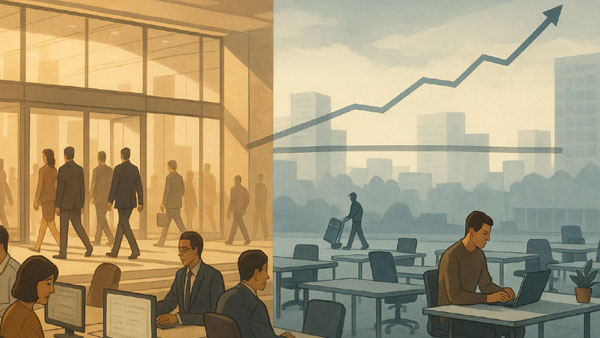Jobs Divide in the Post-Pandemic Era
By Dipak Kurmi
Human civilisation has always been shaped by its instinct to seek patterns, to link one event with another, and to weave narratives about causes and consequences. This tendency, deeply embedded in human cognition, often leads us to mistake correlation for causation. As Rumi observed centuries ago, what appears to be an effect may well be the true cause of a future chain of events, and what seems like an end could simply be the beginning of something else. A fruit grows because of the plant, the plant grows because of the roots, and the gardener nurtures the plant precisely because of the fruit he expects. In this endless circularity, cause and effect frequently blur, merge, or even reverse. This philosophical backdrop becomes particularly relevant when analysing a viral graph circulating on social media, which juxtaposes two major indicators of the American economy: the S&P 500 index and new job creation in the United States since 2000
The chart in question presents a curious symmetry. For nearly two decades, until around 2022–23, both lines—the rise of the S&P 500 and the pace of job creation—appear to move almost in tandem, almost like twins joined at the hip. When the stock index climbed, new jobs rose alongside it; when the index dipped, job growth faltered. The connection seems so tight that one can easily imagine an umbilical bond stitching both graphs together. The question then arises: which drives which? One might argue that robust job creation spurs productivity, boosts revenues, and builds investor confidence, thus pushing stock indices upward. Or, conversely, a booming stock market—often driven by favourable policy changes, low interest rates, and abundant liquidity—could allow companies to raise capital, enlarge capacities, and hire more workers. In both interpretations, the two lines appear logically intertwined.
There are several plausible explanations behind this long-standing synchronicity. Businesses naturally expand their workforce when they foresee rising demand, anticipating higher production and greater profits. Stock markets, which operate on both current performance and expectations of future earnings, tend to reward such optimism. Moreover, macroeconomic triggers such as fiscal stimulus, deregulation, and monetary easing often simultaneously stimulate equity markets and labour markets. This explains why the two curves behaved almost like perfect mirror images of one another for years. Yet the analyst who charted these lines proposed a disruptive new interpretation: the divergence beginning 2022–23 is not accidental, but the direct result of artificial intelligence entering the workspace.
The introduction of ChatGPT in late 2022 gave this argument a symbolic anchor. According to the viral theory, AI tools rapidly infiltrated managerial workflows, boosting productivity while making certain tasks redundant. As AI improved efficiency and reduced the need for routine human labour, companies allegedly began to shed workers even as profits soared. Under this logic, the S&P 500 surged precisely because companies could deliver higher outputs with fewer employees, while new job creation slowed because human labour was no longer essential. It is an appealing narrative, neat and intuitive, and it has circulated widely across digital platforms. Supporting this argument is a CNBC flash survey which reveals that nine out of ten HR leaders expect AI to reshape roles within a year, with more than two-thirds admitting AI is already influencing their organisations. A significant share even believes half or more of their job portfolios are affected, and close to 30 per cent anticipate lowering headcount by 2026, often under the pretext of cost-cutting rather than genuine efficiency gains.
Yet this narrative commits a classic analytical error: it conflates coincidence with causation. AI is undoubtedly transforming workplaces, reducing the need for certain repetitive and entry-level functions, and accelerating a shift toward leaner organisations. Global projections estimating up to 300 million jobs at risk from automation cannot be dismissed lightly. And advocates of technological optimism argue that new AI-enabled roles will offset these losses through reskilling and innovation. But the assumption that AI is the primary driver behind the divergence between the S&P index and job creation oversimplifies a much more complex reality.
To begin with, the post-Covid economic transition profoundly shaped both labour markets and corporate performance. Hundreds of millions across the world lost jobs during the pandemic’s peak, and an even larger number shifted to remote work. When economies reopened, companies discovered that they could sustain operations with smaller teams and lower overheads. Many of the workers laid off during the crisis were never called back. Large sections of the remote workforce were either pressured into hybrid models or converted into lower-paid consultants. The labour force shrank structurally because businesses realised that their productivity could remain stable, or even rise, with fewer people. This naturally suppressed job creation rates even as employers grew more efficient.
Simultaneously, profits soared across sectors during the Covid years. Revenues did dip, but costs plummeted dramatically, especially labour, administrative and operational expenses. This created an unusual scenario in which leaner balance sheets produced inflated profit margins. Stock markets, quick to sense favourable financial metrics, soared within months of the 2020 and 2021 collapses. Investor expectations improved sharply, speculative enthusiasm returned, and valuations expanded rapidly—driving indices like the S&P 500 to record highs. The divergence between a booming market and weak job creation was, therefore, not a product of AI alone but a post-pandemic restructuring of the global economic order. The timing coincided with the launch of ChatGPT, prompting analysts to misinterpret simultaneity as causation.
Another major factor contributing to this divergence was the global shift toward the China+1 strategy. As firms attempted to reduce their dependency on China for manufacturing and supply chains, they relocated operations to other regions. Countries like India and the Philippines benefited from their low-cost labour pools, but many companies shifted production to Latin America, Eastern Europe, and North America—regions with much higher wage structures. Faced with higher manpower costs, many firms opted to invest in automation and technology instead of expanding their human workforces. Capital expenditure on machines was a one-time cost and often came with tax incentives, whereas hiring expensive labour implied ongoing expenses. This global recalibration further depressed job creation while stock indices remained buoyant due to improved cost efficiencies and renewed production stability.
Thus, while AI undoubtedly plays an important role in reshaping the labour ecosystem, it is only one ingredient in a much larger set of economic, structural, and geopolitical changes. The divergence between the S&P and job creation is the consequence of a confluence of forces: pandemic-induced workforce reductions, cost-driven restructuring, shifts in global supply chains, uneven economic recovery, inflation dynamics, and yes, the rising tide of AI tools. Reducing this phenomenon to a single technological moment overshadows the deeper structural patterns shaping the global economy.
What emerges ultimately is a cautionary tale about the misinterpretation of patterns. The human mind is trained to look for clean narratives and dramatic inflection points. The launch of ChatGPT provided a convenient milestone around which to organise a broader economic story. But as Rumi reminded, what appears to be an effect may not be the true cause. The divergence between markets and jobs in 2022–23 is not a story of one catalyst but a complex interplay of economic transitions. AI accelerated a trend already in motion; it did not create it. In the larger arc of history, both lines may converge once again when new industries emerge and labour markets adapt. For now, the divergence merely reflects a world reorganising itself after an unprecedented global shock, while technologies rise not as the primary forces but as companions to far deeper structural shifts.
(the writer can be reached at dipakkurmiglpltd@gmail.com)




